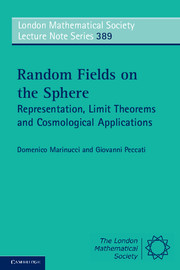Book contents
- Frontmatter
- Contents
- Preface
- 1 Introduction
- 2 Background Results in Representation Theory
- 3 Representations of SO(3) and Harmonic Analysis on S2
- 4 Background Results in Probability and Graphical Methods
- 5 Spectral Representations
- 6 Characterizations of Isotropy
- 7 Limit Theorems for Gaussian Subordinated Random Fields
- 8 Asymptotics for the Sample Power Spectrum
- 9 Asymptotics for Sample Bispectra
- 10 Spherical Needlets and their Asymptotic Properties
- 11 Needlets Estimation of Power Spectrum and Bispectrum
- 12 Spin Random Fields
- 13 Appendix
- References
- Index
2 - Background Results in Representation Theory
Published online by Cambridge University Press: 07 October 2011
- Frontmatter
- Contents
- Preface
- 1 Introduction
- 2 Background Results in Representation Theory
- 3 Representations of SO(3) and Harmonic Analysis on S2
- 4 Background Results in Probability and Graphical Methods
- 5 Spectral Representations
- 6 Characterizations of Isotropy
- 7 Limit Theorems for Gaussian Subordinated Random Fields
- 8 Asymptotics for the Sample Power Spectrum
- 9 Asymptotics for Sample Bispectra
- 10 Spherical Needlets and their Asymptotic Properties
- 11 Needlets Estimation of Power Spectrum and Bispectrum
- 12 Spin Random Fields
- 13 Appendix
- References
- Index
Summary
Introduction
A basic result of standard harmonic analysis on ℝ is that every 2π-periodic function can be expanded into an orthonormal basis of trigonometric polynomials of the type {exp(ikx): k = 0, ±1, ±2,…}. This fundamental fact is exploited in several branches of applied mathematics: in particular – as we shall mention more extensively in the subsequent chapters – it is a main staple in the analysis of stationary stochastic processes. A proof can be provided by elementary techniques, requiring little more than standard calculus – see for instance Rudin [174, p. 88]. It is also well-known (see e.g. [63]) that one can deduce a similar result for fields defined on the sphere S2, where the appropriate orthonormal basis is given by the class of spherical harmonics.
The aim of this introductory chapter is to put these two results into the broader framework of abstract harmonic analysis on compact groups.
At first sight, this choice may seem unduly complicated, but it is indeed necessary for the purposes we are aiming at. On one hand, our standpoint allows us to develop quite straightforwardly Fourier analysis on the sphere. On the other hand, group representation ideas are necessary to understand most of the material presented in the subsequent parts of the book, namely: the characterizations of isotropy, the explicit computation of higher order moments and angular polyspectra, the derivation of high-frequency asymptotic properties, and the discussion of spin ideas at the very end of the book.
- Type
- Chapter
- Information
- Random Fields on the SphereRepresentation, Limit Theorems and Cosmological Applications, pp. 12 - 44Publisher: Cambridge University PressPrint publication year: 2011

